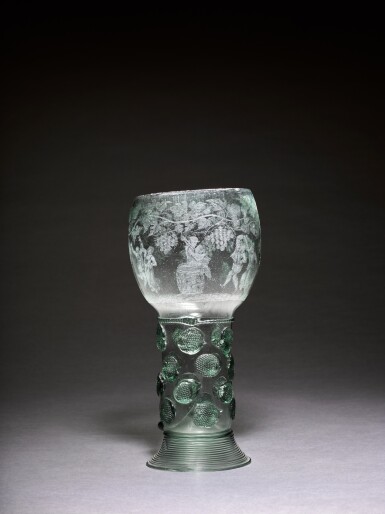
A Dutch diamond-point engraved green glass roemer, circa 1680
Auction Closed
June 10, 02:51 PM GMT
Estimate
10,000 - 15,000 GBP
Lot Details
Description
of conventional form, the bowl engraved in the manner of Willem Mooleyser with a bucolic frieze of dancing revelers and a bagpiper seated on a barrel below a meandering band of fruiting vine, above an engrailed band, the hollow stem applied with four rows of raspberry prunts, supported by a coiled tapering foot
Height 26 cm., 10 1/4 in.
Although the use of roemers was widespread in the seventeenth century, it remained restricted to the relatively wealthy and surviving examples embellished with engraved decoration, which might have been of particular significance to the original owners, are rare. Fine-line engraving on glass with a stylus fitted with a diamond-shard is an early free-hand technique thought to have been used by the Romans and in the Islamic world. It was revived by the Venetian mirror and glass makers in the 16th century and perfected by engravers in Holland in the 17th century who would decorate vessels in a variety of ornamental styles. Their repertoire included calligraphic and botanical studies, historical and religious subjects, portraits and coats of arms.
The present lot is engraved in the manner of Willem Mooleyser (c. 1640-1700) of Rotterdam who was active in the second half of the 17th century. Although little is known about him, a small number of signed pieces, some dated, provide a reference for his style, which is distinguished by a scribbled freedom and vigour, often with infilling to the figures and fruit and foliage borders. With the exception a signed glass, dated 1663, in the Rijksmuseum, Amsterdam (no. BK-KOG-1544), they were all engraved in the last two decades of the 17th century. Three closely related pieces to the present lot are in the Victoria and Albert Museum, London: a documentary armorial roemer of similarly large scale, engraved with the Arms of the Dutch Republic, the Seven United Provinces, and William and Mary of Orange (no. C.297-1936), signed ‘W.M.’ and dated 1689; another roemer, engraved in the manner of Mooleyser, with vines and dancing peasants and a bagpipe player seated on a barrel (no. C.293-1936) and a cylindrical beaker, signed and dated: ‘W.Mooleyser 1685’, also engraved with dancing peasants below a similar vine border. Finally, a Dutch late 17th century glass goblet, engraved with an almost identical figure of a bagpiper seated on a barrel to that on our glass,in the manner of Mooleyser, is in the Art Institute of Chicago (no. 1927.1317). By the end of the century, this type of diamond-point work fell from favour as wheel engraved decoration became more popular.
Roemers, made of green tinted Waldglas (forest glass), were large drinking vessels for wine, with hollow stems studded with prunts and a foot made from a single thread of molten glass spun around a wooden conical form. The prunts, applied blobs of glass stamped with fireproof clay or metal to form a pattern, were intended not only as a decorative motif but also to ensure a safe grip. Born of the Roman glass making tradition, established as early as the third century AD at sites along the Rhine, plain roemers were made in the many German forest glasshouses during the seventeenth century, and exported throughout Europe. They were also made in quantity in the Low Countries. Roemers frequently feature in Dutch seventeenth century still-life painting and portraiture of the Golden Age. In the work of Pieter Claesz and his school, roemers and other forms of glass drinking vessels such as a façon-de-venise flutes or pasglas appear with domestically produced silver and pewter as well as imported stoneware and exotic Chinese porcelain, surrounded or filled with produce. Production of the form was revived in the 19th century and it still remains popular, especially in Holland and Germany.
You May Also Like










